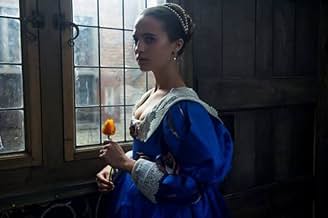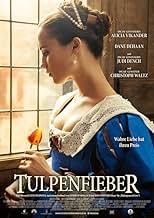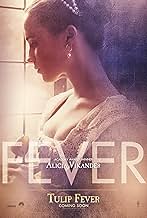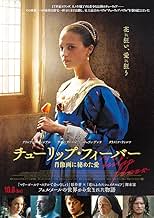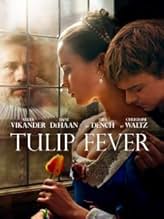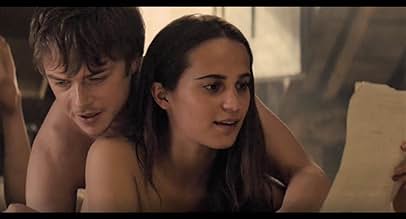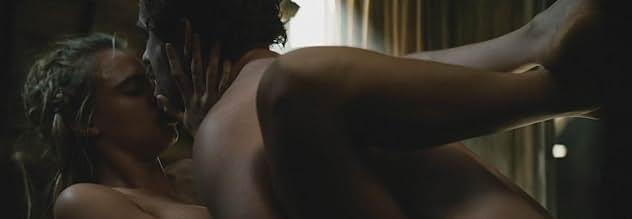VALUTAZIONE IMDb
6,2/10
23.953
LA TUA VALUTAZIONE
Un artista si innamora di una giovane donna sposata quando gli viene commissionato di ritrarla, durante la mania dei tulipani del XVII secolo ad Amsterdam.Un artista si innamora di una giovane donna sposata quando gli viene commissionato di ritrarla, durante la mania dei tulipani del XVII secolo ad Amsterdam.Un artista si innamora di una giovane donna sposata quando gli viene commissionato di ritrarla, durante la mania dei tulipani del XVII secolo ad Amsterdam.
- Regia
- Sceneggiatura
- Star
- Premi
- 1 candidatura in totale
Richard Alan Reid
- Bidder 1
- (as Richard Reid)
Recensioni in evidenza
A pretty good period piece set in an interesting location during an even more interesting time, could have been great, but overall it's still good enough.. Christoph Waltz walks on water as always!
Here is only one review of the 2014-version. Based on that review, it is fair to say that some of the plot holes have obviously been stuffed, while others are still wide open (or have been opened). I don't know if the holes have been faithfully adapted from the book or if they were specifically designed for the film.
In the 16th century there was a big economic bubble based on tulip onions. This is the background for a romance between a painter and a married woman. They make out a plan to get rich fast, so that they can run away to the East Indies. So far, so good. The point is now that the two strings never really are woven properly together. The development of the plot is, at best, sketchy. Character development, if any, is rather rhapsodical. The lovers (Vikander and DeHaan) are not really likable. The script gives them zero personality and they compensate by overacting. The only person carrying a bit of sympathy is the cheated husband (Waltz). On the other hand the makers strive to give us impressions of street life then, raw, loud and rather vulgar it is in their view. The final twist of the plot is surprising, but not convincing.
There are further things that were rather annoying in this film: The use of a narrator. It seemed that the makers didn't trust the force of their pictures and thought they had to spell it out for more distracted viewers. Shaky camera and fast clipping. I think it is a misconception to edit a costume drama to fit the taste of the MTV generation. (Make it more like The Girl with a Pearl Earring!)
One reason for historical fiction is to make us understand the burst of the recent economic bubble on the basis of a historical example. The makers of this film didn't really succeed in doing that. The persons in this film are far away and two-dimensional like drawings on a wall. Unless you write a review about them, you have already forgotten them tomorrow.
In the 16th century there was a big economic bubble based on tulip onions. This is the background for a romance between a painter and a married woman. They make out a plan to get rich fast, so that they can run away to the East Indies. So far, so good. The point is now that the two strings never really are woven properly together. The development of the plot is, at best, sketchy. Character development, if any, is rather rhapsodical. The lovers (Vikander and DeHaan) are not really likable. The script gives them zero personality and they compensate by overacting. The only person carrying a bit of sympathy is the cheated husband (Waltz). On the other hand the makers strive to give us impressions of street life then, raw, loud and rather vulgar it is in their view. The final twist of the plot is surprising, but not convincing.
There are further things that were rather annoying in this film: The use of a narrator. It seemed that the makers didn't trust the force of their pictures and thought they had to spell it out for more distracted viewers. Shaky camera and fast clipping. I think it is a misconception to edit a costume drama to fit the taste of the MTV generation. (Make it more like The Girl with a Pearl Earring!)
One reason for historical fiction is to make us understand the burst of the recent economic bubble on the basis of a historical example. The makers of this film didn't really succeed in doing that. The persons in this film are far away and two-dimensional like drawings on a wall. Unless you write a review about them, you have already forgotten them tomorrow.
I had the privilege of seeing this film in preview in the famous Tuschinski theatre in the heart of the canal district in Amsterdam. Having enjoyed the novel whilst living there in 2011, I have watched as it's release dates have been continually changed giving all the signs of a production in distress. Early rumours of poor test screenings can be damaging whether true or not! Like another reviewer I found the opening narration at odds with the images and consequently confusing. The first 40 minutes edited in a pedestrian style merely to tick off necessary plot points, and without any sensitivity to mood or place, so prevalent in the novel. Strangely, the movie seemed to be both full of beautiful 'pictures', historical detail, visual treats and mood, and yet at the same time, the continued use of one street set left it feeling small and enclosed and almost like stage set. Little sense of Amsterdam as a City State enjoying a glorious rise on the world stage. At that point (after 40 minutes) having laid out the plot points and established the characters, the film starts to build, thanks to the real tension in the original story, a good script and some fine performances. I got over a niggling feeling of disappointment at the 'smallness' of the set production, and instead decided to enjoy the abundant visual detail and the way the story started to rip along. Ultimately the great story rose above the shaky first reel and the production design above its limited scale. I was with two friends who hadn't read the book, and we all three came to really enjoy the film, despite the confused and hurried beginnings. It deserves to rise above its production history and be widely seen and enjoyed. It doesn't quite reach the heights of the source material, but it's far from a failure with much to enjoy.
Great cast! Fine Acting! Glossy cinematography! Terrific sets! Excellent costuming! Even an intriguing first half of the film! Yet, ultimately Justin Chadwick's historical romantic drama concerning a 17th-century painter in Amsterdam who falls in love with a married woman whose portrait he has been commissioned to paint, during the period known as "Tulip Mania", fails due to its implausible, improbable, narrative outcomes.
It just goes to show that films left on the studio shelves for 3 years after being completed, before being released, as was the case with Tulip Fever, are usually top - shelved for good reason. In this case the film seems to have suffered through a combination of script and editing deficiencies and some poor directorial choices. It results in a movie that doesn't seem to know whether it wants to be some sort of comedy - drama, or straight out melodrama in corsets.
Whether due to editing or some other production choice, nothing much is ever made really clear. The titular, historically authentic,Tulip Fever itself is barely sketched out and then only against the incessant noise and rowdy crowds of Amsterdam's flower markets. Early in the film a quite close and friendly relationship is hinted at between the 2 female leads, Sophia (Alicia Vikander), a wealthy merchant's unhappy young wife and her maidservant, the more earthy and world - wise Maria (Holiday Grainger). Their love - lives are compared and contrasted with Sophia clearly ensnared in a loveless arranged marriage. But this thread is never really consolidated.
Instead we are served up a mish - mash of multiple storylines concerning fake and real pregnancies, suspicious lovers and various characters seeking their fortunes through investment in an over - heated tulip market. It all ends up being ludicrously implausible and both unfunny and undramatic, with a tacked on, unconvincing conclusion. What a waste!
I've given it a 6, because I'm sure there will be some, who like me, appreciate historical films such as this, with obviously high production values. There's no getting around the fact that Tulip Fever looks good. And Alicia Vikander is perfect as Sophia, plucked from obscurity in an orphanage and selected to marry for her great beauty. Similarly, Grainger succeeds as the pragmatic, Maria, who is anything but a dullard, or your conventional notion of a put upon servant. But these positives can't disguise that Tulip Fever ends up looking and sounding like a completely miscalculated opportunity, rather than a significantly interesting, period drama.
It just goes to show that films left on the studio shelves for 3 years after being completed, before being released, as was the case with Tulip Fever, are usually top - shelved for good reason. In this case the film seems to have suffered through a combination of script and editing deficiencies and some poor directorial choices. It results in a movie that doesn't seem to know whether it wants to be some sort of comedy - drama, or straight out melodrama in corsets.
Whether due to editing or some other production choice, nothing much is ever made really clear. The titular, historically authentic,Tulip Fever itself is barely sketched out and then only against the incessant noise and rowdy crowds of Amsterdam's flower markets. Early in the film a quite close and friendly relationship is hinted at between the 2 female leads, Sophia (Alicia Vikander), a wealthy merchant's unhappy young wife and her maidservant, the more earthy and world - wise Maria (Holiday Grainger). Their love - lives are compared and contrasted with Sophia clearly ensnared in a loveless arranged marriage. But this thread is never really consolidated.
Instead we are served up a mish - mash of multiple storylines concerning fake and real pregnancies, suspicious lovers and various characters seeking their fortunes through investment in an over - heated tulip market. It all ends up being ludicrously implausible and both unfunny and undramatic, with a tacked on, unconvincing conclusion. What a waste!
I've given it a 6, because I'm sure there will be some, who like me, appreciate historical films such as this, with obviously high production values. There's no getting around the fact that Tulip Fever looks good. And Alicia Vikander is perfect as Sophia, plucked from obscurity in an orphanage and selected to marry for her great beauty. Similarly, Grainger succeeds as the pragmatic, Maria, who is anything but a dullard, or your conventional notion of a put upon servant. But these positives can't disguise that Tulip Fever ends up looking and sounding like a completely miscalculated opportunity, rather than a significantly interesting, period drama.
Tulipmania is one of Europe's weirder historical events. Unfortunately, the movie barely touches on the tulip market craze, except as a deus ex machina to bestow sudden wealth and/or loss on characters who we barely care about and who do nothing to deserve it.
The main problem with the film is that the love triangle that is supposed to be the main story appears out of nowhere -- one of the characters simply looks up pensively, as if he just solved a riddle, and declares, "I'm in love!" Up until that point, he had shared maybe 60 seconds of screen time with the object of his affection. How can we care about the contrived swings in fortune of such shallow people?
Making things worse, this love triangle movie has five main characters, leading to underdeveloped characters, repetition of ideas and unnecessary subplots.
I loved the sets and I thought that Christoph Waltz, Holliday Grainger and Jack O'Connell did great jobs with the little they had to work with.
The main problem with the film is that the love triangle that is supposed to be the main story appears out of nowhere -- one of the characters simply looks up pensively, as if he just solved a riddle, and declares, "I'm in love!" Up until that point, he had shared maybe 60 seconds of screen time with the object of his affection. How can we care about the contrived swings in fortune of such shallow people?
Making things worse, this love triangle movie has five main characters, leading to underdeveloped characters, repetition of ideas and unnecessary subplots.
I loved the sets and I thought that Christoph Waltz, Holliday Grainger and Jack O'Connell did great jobs with the little they had to work with.
Lo sapevi?
- QuizThis movie was shot in 2014 but the release was postponed for three years. The first test screening happened in November 2014 and didn't get positive reactions. This movie was originally scheduled to be released in June 2016, but the release date was pushed to July 2016, then to February 2017, August 25, 2017, and it was finally released in theaters in September 1, 2017.
- BlooperWhen Jan is telling the bailiffs "if I was liquid now I'd be a bigger fool than I look," his mouth stops moving well before the dubbed line finishes.
- Citazioni
Cornelis Sandvoort: First to flower, first to fall.
- ConnessioniReferenced in Midnight Screenings: Valley of Bones (2017)
I più visti
Accedi per valutare e creare un elenco di titoli salvati per ottenere consigli personalizzati
- How long is Tulip Fever?Powered by Alexa
Dettagli
- Data di uscita
- Paesi di origine
- Siti ufficiali
- Lingua
- Celebre anche come
- Tulip Fever
- Luoghi delle riprese
- Aziende produttrici
- Vedi altri crediti dell’azienda su IMDbPro
Botteghino
- Budget
- 25.000.000 USD (previsto)
- Lordo Stati Uniti e Canada
- 2.455.635 USD
- Fine settimana di apertura Stati Uniti e Canada
- 1.158.017 USD
- 3 set 2017
- Lordo in tutto il mondo
- 9.204.549 USD
- Tempo di esecuzione1 ora 45 minuti
- Colore
- Mix di suoni
- Proporzioni
- 2.35 : 1
Contribuisci a questa pagina
Suggerisci una modifica o aggiungi i contenuti mancanti

Divario superiore
What is the Hindi language plot outline for La ragazza dei tulipani (2017)?
Rispondi






